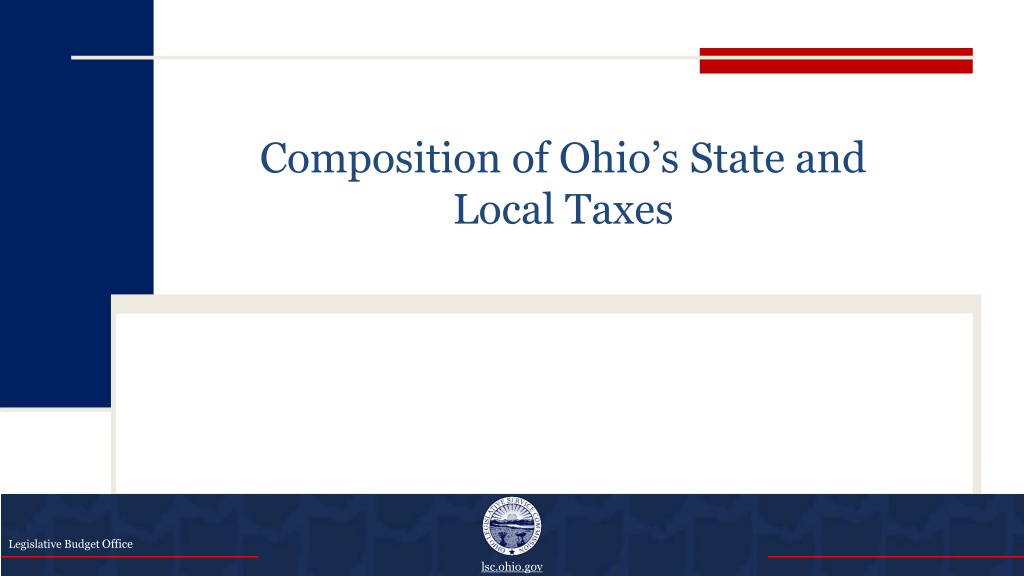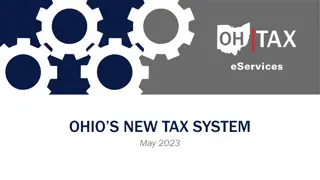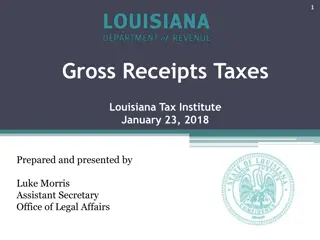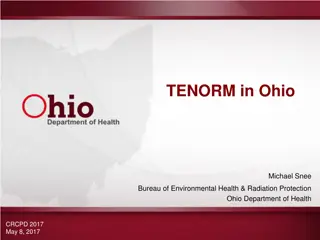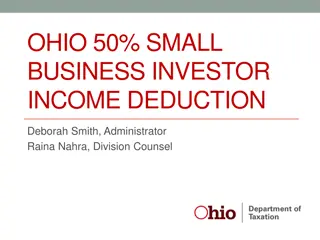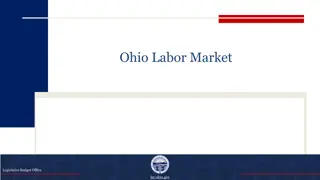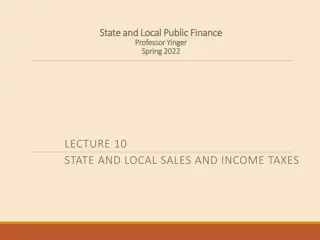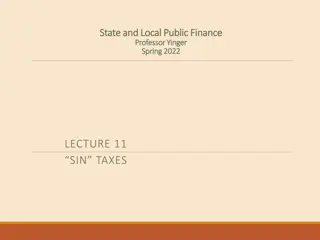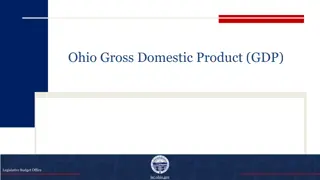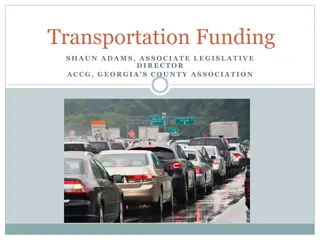Composition of Ohio's State and Local Taxes Revealed
Ohio relies heavily on sales taxes for state and local government tax revenue. In FY 2019, Ohio's combined state and local tax revenue sources included property taxes, individual income tax, and sales taxes. Sales taxes accounted for the highest percentage of revenue, followed by property taxes and individual income tax. Ohio's tax revenue as a percentage of personal income exceeds the national average and that of neighboring states. The state's reliance on income taxes as a percent of personal income is lower compared to most neighboring states.
Download Presentation

Please find below an Image/Link to download the presentation.
The content on the website is provided AS IS for your information and personal use only. It may not be sold, licensed, or shared on other websites without obtaining consent from the author. Download presentation by click this link. If you encounter any issues during the download, it is possible that the publisher has removed the file from their server.
E N D
Presentation Transcript
Composition of Ohios State and Local Taxes Legislative Budget Office lsc.ohio.gov lsc.ohio.gov
Ohio relies heavily on sales taxes for state and local government tax revenue Ohio combined state and local tax revenue by source, FY 2019 U.S. combined state and local tax revenue by source, FY 2019 All Total: $56.20 billion Total: $1,863.76 billion Other Taxes 10% Property Taxes 29% Individual Income Tax 24% All Other Taxes 5% Property Taxes 31% Sales Taxes* 39% Individual Income Tax 27% Sales Taxes* 35% *Sales taxes include general state and local sales tax and gross receipts taxes on sales of specific products, including tobacco products, alcoholic beverages, motor fuels, and utility services. Source: U.S. Census Bureau In FY 2019, state and local taxes on sales, property, and individual income in Ohio raised about 95% of total tax revenues. For all U.S. states in total, state and local taxes on sales, property, and individual income raised about 90% of total tax revenues. State taxes and local taxes accounted for 55% and 45%, respectively, of Ohio s combined state and local tax revenue in FY 2019. For the U.S. as a whole, state taxes were 58% of combined state and local tax revenue while local taxes were 42% of the combined total. lsc.ohio.gov lsc.ohio.gov Legislative Budget Office
Ohios sales tax receipts as a percentage of personal income exceed the average of neighboring states and the national average State and Local Tax Revenue as a Percent of Personal Income, FY 2019 In FY 2019, Ohio s general and selective sales tax receipts were 3.7% of total personal income, which was higher than the national average (3.6%) and was also higher than the average of its five neighboring states (3.6%). Selective sales taxes apply to specific products, including motor fuel, alcoholic beverages, tobacco products, and public utilities. Ohio s state and local individual income tax receipts as a percentage of total personal income were 2.6%, higher than the U.S. average (2.5%), but lower than the average of its five neighboring states (2.8%). Ohio s percentage was 3.4% in FY 2008, but has been decreasing in recent years due primarily to income tax policy changes. Ohio s property taxes were 2.8% of total personal income, which was lower than the national average (3.2%), but higher than the average of its five neighboring states (2.5%). 4.0% 3.7% 3.6% 3.6% 3.5% 3.2% 3.0% 2.8% 2.8% 2.6% 2.5% 2.5% 2.5% 2.0% 1.5% 1.0% 0.5% 0.0% General & Selective Sales Sources: U.S. Census Bureau; Bureau of Economic Analysis Individual Income Property Ohio U.S. Neighboring States lsc.ohio.gov lsc.ohio.gov Legislative Budget Office
Ohios state and local governments rely less on income taxes as a percent of personal income than most neighbors In FY 2019, Ohio s individual income tax receipts were 2.6% of total personal income, which was the same as Pennsylvania and higher than Michigan, but lower than West Virginia, Indiana, and Kentucky. Ohio s general and selective sales tax receipts were 3.7% of total personal income, which was the same as Kentucky, higher than Pennsylvania and Michigan, but lower than West Virginia and Indiana. Ohio s property tax receipts were 2.8% of total personal income, which was higher than Kentucky, West Virginia, and Indiana, but lower than Pennsylvania and Michigan. State and Local Tax Revenue as a Percent of Personal Income for Ohio and Neighboring States, FY 2019 General & Selective Sales State Individual Income Property Ohio 2.6% 2.8% 3.7% Indiana 3.1% 2.3% 4.0% Kentucky 3.2% 2.1% 3.7% Michigan 2.2% 3.1% 3.0% Pennsylvania 2.6% 2.9% 3.2% West Virginia 2.8% 2.3% 3.9% Sources: U.S. Census Bureau; Bureau of Economic Analysis lsc.ohio.gov lsc.ohio.gov Legislative Budget Office
